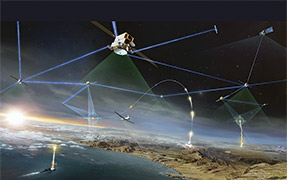An automatic pipeline can detect highly variable sources in astronomical images
Some astrophysical objects are known to have very large luminosity variations, for example, the optical afterglows of gamma-ray bursts (GRBs). These events occur at random times and positions in the sky, and can only be observed during a few hours to a few days. All GRBs recorded to date have been detected due to their high-energy emission, and their afterglows have been observed thanks to the fast and accurate localization of the gamma-ray source. Observations and theoretical predictions describe GRBs as a prompt emission beamed into a narrow jet and afterglow emission as more isotropic, hence capable of being detected by off-axis observers. These particular types of afterglows, not associated with visible GRBs, are called orphan afterglows.
In recent years, orphan afterglows have been actively searched for since they can provide useful clues to the nature of GRBs. For instance, they offer a complementary way to test the beaming hypothesis and to measure the beaming factor. It is also believed that they could help estimate the local GRB population and detect GRBs with little or no gamma-ray emission. Searches for orphan afterglows have been attempted by a few teams.1–3 None, however, has led to the detection of an afterglow, due to low-sensitivity observation or insufficient sky coverage.
The Canadian and French astronomical communities are conducting major astronomical surveys with the Canada-France-Hawaii Telescope (CFHT). One of them—the Very Wide (VW) survey—provides an unprecedented combination of depth and width for orphan afterglow searches. Within this framework, we have developed a dedicated real-time analysis system (RTAS), called optically selected GRB afterglows, to search for highly variable objects in the images collected by this survey.4 Our fully automatic pipeline (see Figure 1) creates catalogs of object images as soon as they are acquired, compares catalogs of the same field, and extracts a list of variable and transient sources.

Highly variable or transient sources are objects that appear only once. To search for them in astronomical images involves observing the same region of the sky several times using a strategy based on the timescale variability of the studied objects. The images are then compared with extract objects that show luminosity variations, new sources, or sources that have disappeared. In the case of afterglows, their scarcity and fast luminosity decay requires wide and deep observations followed by quick image analysis. This is why our method is based on comparing catalogs of objects.
We chose to perform our search for afterglows in the images acquired for the CFHT-VW survey, which covers a thousand square degrees down to a decent magnitude (>22). Since each CFHT-VW field is observed several times within the same lunar dark period, we can use this recurrence to look for objects that are variable or transient on a timescale of a few days.
Within 24h of image acquisition, objects are manually checked by a member of the collaboration who may select to reject an object as a false detection (for instance, due to a CCD defect), or validate it as truly variable (for instance, a variable star). This verification is done using an interactive and user-friendly Internet script. Validated objects are then carefully examined to identify them using available archives.
Since implementing our RTAS, we have analyzed more than 490 square degrees down to magnitude r'=22.5, leading to the detection of ~20 million objects, of which 0.07% were characterized as variable. However, only 10% of these—i.e., 1067 objects—could be validated as truly variable sources. Most were variable stars, including flare stars whose behavior may be similar to that of an afterglow at short timescales. We were left with 3 afterglow candidates.5 Two were unlikely but could not be rejected due to lacking reference images. The third, however, exhibited a typical afterglow luminosity decrease (see Figure 2).
To perform a search for a specific type of astronomical transient, namely, GRB afterglows, we have developed an RTAS that creates catalogs of sources and compares them with extract variable and transient objects. Analysis of the real-time outputs clearly demonstrates the efficiency of our system, since 99.5% of the images were properly and quickly processed with <0.1% of the objects requiring human characterization. The results of our study provide the best characterization to date of the number of afterglows in the sky.5 Our methodology can easily be applied to future searches for highly variable objects. Other planned astronomical surveys, such as the Panoramic Survey Telescope and Rapid Response System and the Large Synoptic Survey Telescope could benefit from the expertise acquired with our RTAS.
Frédéric Malacrino is a PhD student in the Laboratoire d'Astrophysique de Toulouse-Tarbes. He is working on the detection of counterparts of GRBs with Jean-Luc Atteia.




